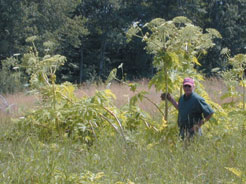Just when you thought it was safe to go back in the garden look out for the giant hogweed! Its clear, watery sap has toxins that cause photodermatitis. Skin contact followed by exposure to sunlight produces painful, burning blisters that may develop into purplish or blackened scars. Contact with the eyes can cause temporary or permanent blindness.
The state of Massachusetts, after identifying its increasing occurrence, issued an alert to farmers, outdoorsmen and gardeners to avoid the plant.
Introduced to the United States as an ornamental plant from central Asia, giant hogweed has become established in New York, Pennsylvania, Oregon and Washington State. Infestations have also been reported in Maine, Michigan and Washington D.C. The plant can grow to 15 feet tall, with four-inch stems that have purple splotches and leaves five feet across at its base. It has large umbrella-shaped flowers.

Dude, thats some totally wicked weed!
Dont be fooled by its pretty appearance, though. This plant is bad news, says Craig Hollingsworth, Ph.D., of the University of Massachusetts and coordinator of the states Cooperative Agricultural Pest Survey. If you believe you have found a giant hogweed, contact the Massachusetts Department of Food and Agriculture at (617) 626-1779.

